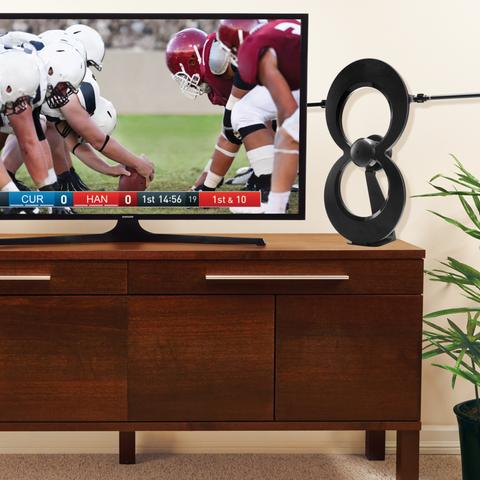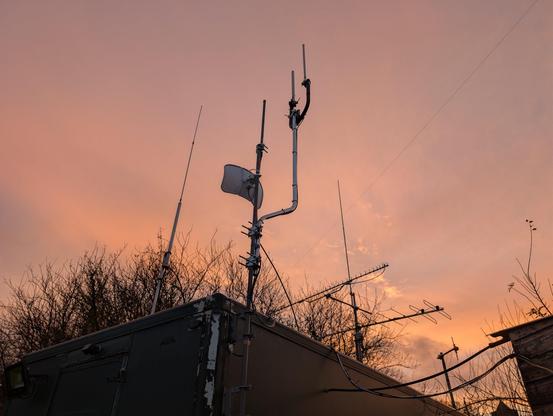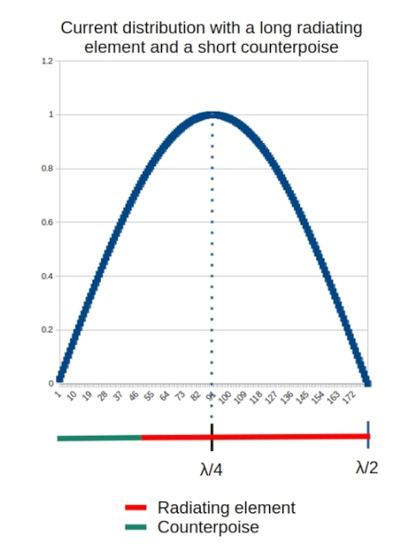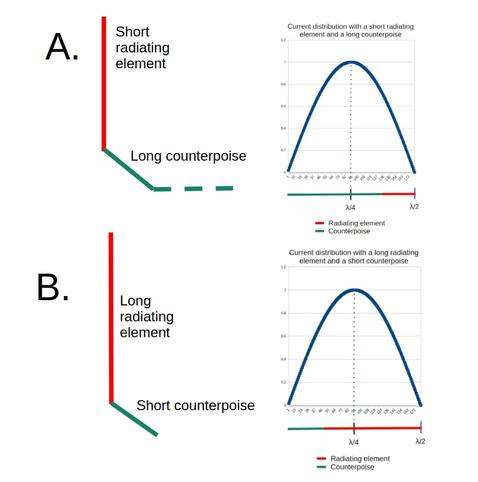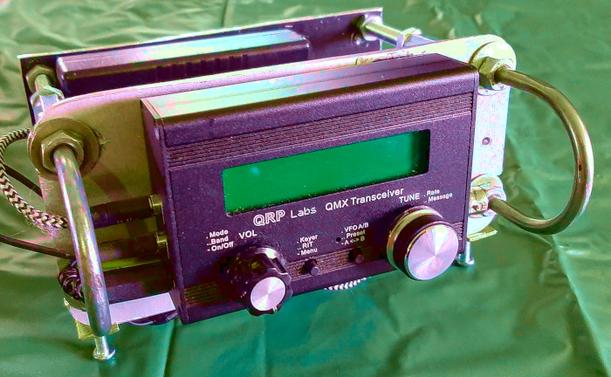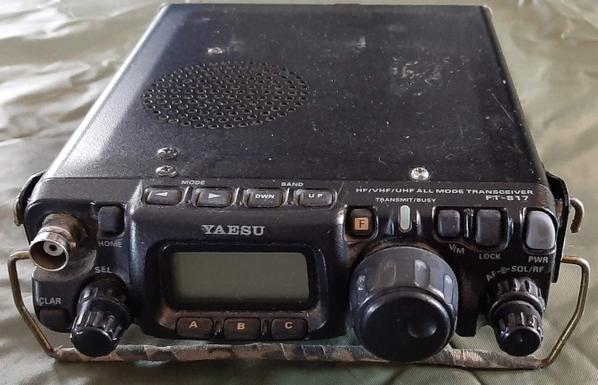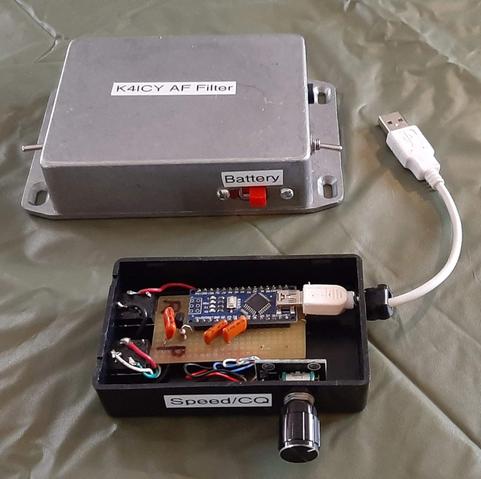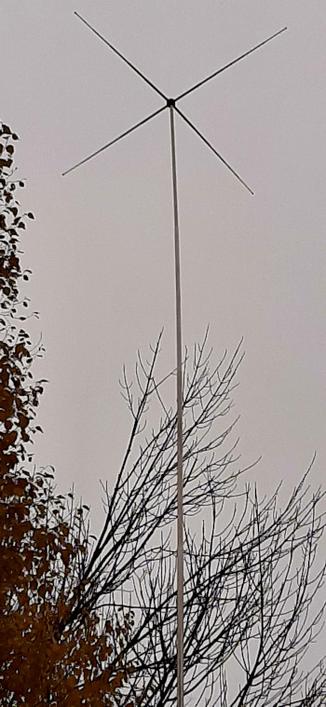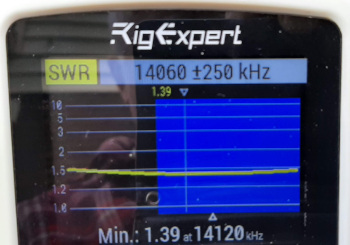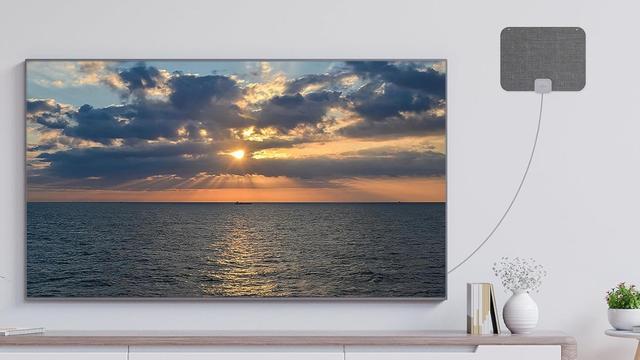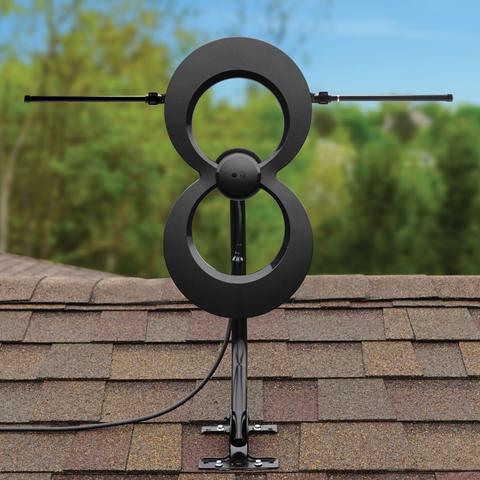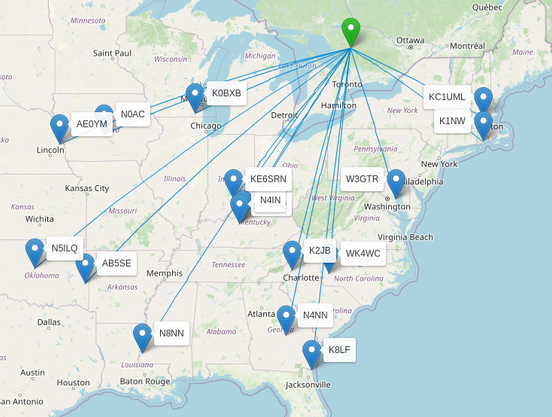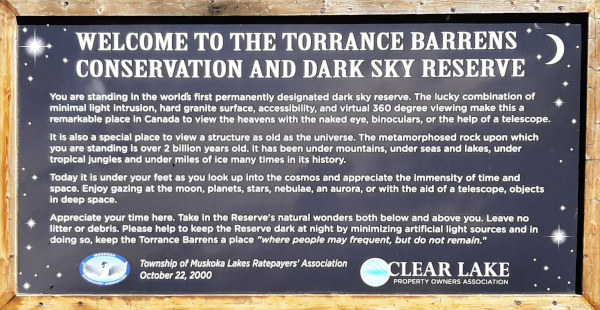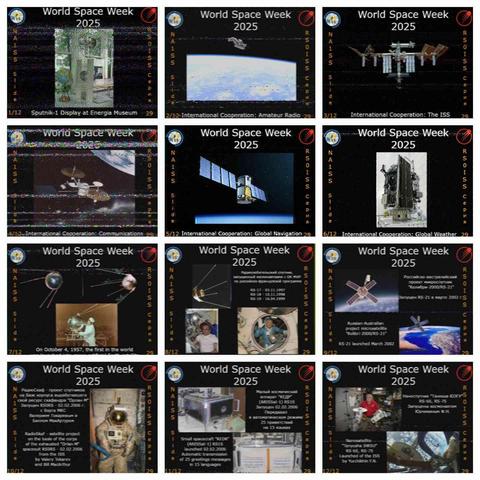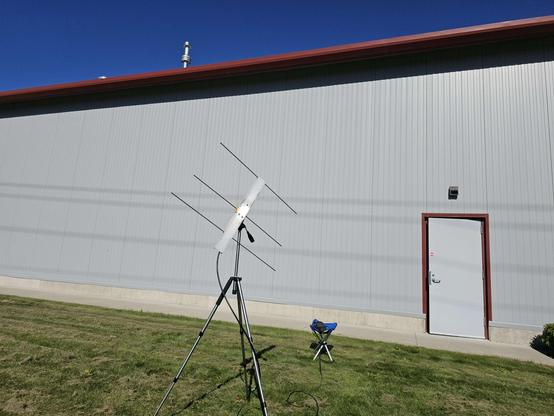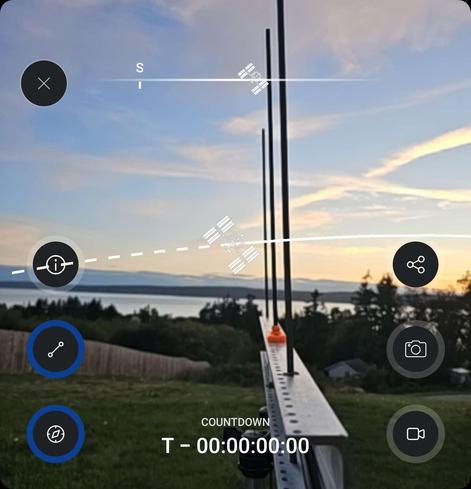Missing NBC? Take 25% Off of a Brand New Antenna Today
#Antennas
POTA PERformer radials – can we make a compromise?
There has only been one light snowfall in southern Ontario so far this season – just a few centimeters that melted away within a couple of days. In anticipation of upcoming heavier snowfalls and a semi-permanent white blanket that will last until spring, I bravely shrugged off the chilly outside air and set up my Ham Radio Outside the Box version of the POTA PERformer antenna out in the backyard to experiment with radial lengths.
The cunningly repaired broken shortened whip with a capacitive top hat, to compensate for its inductive reactance on the 20m band, sat atop my custom spike mount that, despite falling temperatures, could still be pushed into the ground about 25cm (10 inches). Two radials were attached each of which sloped down to a fiberglass stake about a foot (30cm) above ground. The radials are approximately 5m (17ft) long for the 20m band with links to shorten the wires for the 17m and 15m bands.
Now, to find a shortcut
The objective for the day’s tests was to investigate whether compromises could be made in the radial lengths. Why? Later in the winter, when the snow lies deep and crisp and even, it can become a real chore to wade through accumulations of the infernal white stuff to adjust the radial lengths for band changes. I have adopted 2mm banana plugs for the links – a great idea in the summer, but maybe I neglected to consider what will happen when even a few snow flakes freeze on those tiny connectors in the winter!
So, how to minimize pedestrian excursions through the challenges of winter operating conditions to accommodate band changes? The POTA PERformer is an efficient antenna but it was designed in California where the climate is just a little milder than in Ontario. Should I go back to using a random wire antenna – like the Rybakov – until spring comes around again?
I could perhaps use “fan radials” i.e. separate radials for each band. That would probably work but setting them up might still involve wading through deep snow. In the past I have used ground radials laid on the snow – a multiband arrangement that requires no adjustment for band changes, but is less efficient.
Back to the backyard tests; what did I find out?
- First, my approximately 16.5ft (~5m) raised radial wires provided an acceptable SWR (less than 2:1) on 20m and 17m (with the whip length shortened for 17m).
- Second, the same wires – with the links adjusted for 15m and the whip shortened again – gave an acceptable SWR on 15m, 12m and 10m.
So, is this a result? Maybe not. There is a potential for lost efficiency when the radiating element is shorter than the counterpoise. Let me explain.
Let’s assume we are using a field portable version of the POTA PERformer in which the feedpoint remains quite close to the ground – maybe 1 to 1.5 meters. The two radial wires slope away from the feedpoint to an end point even lower to the ground. Now, if we examine the current distribution on a halfwave dipole, we can see that the maximum current, and therefore the point at which maximum RF is radiated, is located in the center of the dipole.
We would like the high current point to lie within the radiating element, not the counterpoise. For the purposes of this discussion we are going to refer to the two radial wires as “the counterpoise”.
Going back to my backyard tests, I found that:
- a 20m counterpoise “worked” on the 17m band.
- a 15m counterpoise also “worked” on the 12m and 10m bands.
In each of these cases the radiating element was shorter than the counterpoise.
Referring to the accompanying diagrams we can see that the high current point, in each case, lies within the counterpoise.
Does this finding matter?
Changing the radiating element versus counterpoise balance creates an antenna that looks very much like an Off Center Fed Dipole (OCFD).
If an OCFD is mounted high enough above ground it doesn’t matter at all although two things need to be considered here:
- Changing the radiating element versus counterpoise lengths changes the impedance at the feedpoint.
- The overall length of the dipole might change unexpectedly. This can be seen with Greg KJ6ER’s Challenger antenna which is a vertical OCFD halfwave dipole that is shortened by laying part of the counterpoise wire on the ground.
A relatively small change in the ratio between the radiating element versus counterpoise lengths changes the feedpoint impedance, but this can be compensated by adjusting the whip length to still obtain a usable SWR.
However, we cannot compensate for the proximity to ground of the counterpoise in the POTA PERformer. If the current maximum occurs at the feedpoint (1 to 1.5 meters above ground) very little power is lost. But, if the current maximum occurs below the feedpoint we are going to keep the earthworms warm in winter.
Not the best plan
So we can conclude that using a 20m counterpoise on 17m risks losing some of our RF energy to the ground. The same applies for using a 15m counterpoise on 12m and 10m. The following diagram summarizes this.
The way forward
“Fan radials” may still be a solution but they require some careful experimentation. There is interaction between the wires for each band due to mutual capacitance. This is compounded when multiple bands are involved. To make matters worse, when used out in the Big Blue Sky Shack where the wind doth blow through the wires and changes the interaction, who knows what wild swings in SWR may occur? The radio I have dubbed my “very clever poodle” (QMX: see last post) will not take kindly to that.
A final thought
I have watched several videos in which a very short whip is mounted on a picnic table and used with a single long counterpoise wire draped down to and across the ground. Sometimes the “Magic (Tune) Button” assists in finding an SWR that keeps the radio smiling. Contacts get made, so what’s the problem? I hope the above discussion answers that question.
Help support HamRadioOutsidetheBox
No “tip-jar”, “buy me a coffee”, Patreon, or Amazon links here. I enjoy my hobby and I enjoy writing about it. If you would like to support this blog please follow/subscribe using the link at the bottom of my home page, or like, comment (links at the bottom of each post), repost or share links to my posts on social media. If you would like to email me directly you will find my email address on my QRZ.com page. Thank you!
The following copyright notice applies to all content on this blog.
This work is licensed under a Creative Commons Attribution-NonCommercial-NoDerivatives 4.0 International License.
#amateurRadio2 #antennas #counterpoise #ground #outdoorOps #pota #qmx
QRP? Are we out of our minds?
If we believe in QRP – I mean really, really believe – then we can make it work. Admittedly it’s like betting on a race between a tortoise and a hare; where would you put your money? If you read accounts written by diehard QRPers, do you ever see stories such as: “I went to the park with my latest QRP rig today and called CQ for five hours but only got 2 QSOs. On the way home I tossed that stupid rig in the river and bought a big-boy radio instead”? Of course not. Diehards enjoy the outing as much as the contacts. They get a thrill out of tickling the ionosphere even if the big bad D-layer swallows their RF and has a malignant chuckle to itself.
I am not a diehard, but I do like to operate QRP whenever it yields a good probability of actually getting contacts. On the other hand, when propagation conditions are unfavorable, or I cannot erect an efficient antenna, I am willing to switch to warp power to get the job done.
The FCC has given us guidance in the form of the Part 97 rules, and to paraphrase them:
“Use (only) as much power as in necessary to make the contact”
There are different ways to interpret that guidance. For many QRO operators it means “fire up the amp and let ‘er rip; life’s too short …”. The word “only” in the above may occasionally fall on deaf ears. QRPers, on the other hand, might see things differently and ask: “How can we make this work without increasing power?”.
There are days when 5 watts into a tiny coil-loaded whip is all you need; for other days there are tricks that can be employed to make a teeny-weeny smidgen of RF create the illusion of a really big-boy signal. The big secret is that it doesn’t matter how much signal the P.A. of our radios – big, small or tiny – presents at the antenna jack. What really counts is how much signal appears at the receiving end.
A military ELF (Extremely Low Frequency) radio station puts out a huge amount of power, but the amount reaching a submarine somewhere beneath the world’s oceans is only a few watts – effectively QRP. QRO operators can emulate that idea by using a dummy load with a random wire antenna attached. No tuner needed, any old antenna will work and the radio will always see a low SWR. It is said to work just fine but with the caveat that you will lose about 1 S-unit in signal strength due to loss in the dummy load. Would it be possible to invert that situation and transmit a very low power signal that a receiving station would perceive to be more powerful?
Don’t announce your handicap
If we call CQ and identify ourselves as QRP we are telling the world we are transmitting a teeny-weeny smidgen of a signal and that negatively influences the receiving station’s perception. In his book “Winning through intimidation” author Robert Ringer tells of clever benevolent techniques he employed in his sales career to dazzle potential clients into having a glowing perception of him. So let’s not mention our piddling power and allow the receiving station to assume we are just another regular ham station, or maybe even a superstation.
Use an efficient antenna
When conditions are right you can make contacts with a wet noodle. In most cases it makes sense to assume conditions are unfavorable and plan for the worst. That means putting up an efficient antenna – one that converts as much of our feeble signal as possible into radiated RF. If we can put up a gain antenna, even 3dB of gain, we will double our effective radiated power.
Don’t use a vertical antenna
Well, ok if we have to use a vertical antenna it should be raised off the ground. A ground mounted vertical antenna requires a lot of radials to be efficient. If it is raised as little as 1 meter above ground less radials will be required – maybe as few as 2.
A vertical antenna radiates equally in every direction so our feeble signal is spread around 360 degrees. If that signal can be focused to favor a specific direction, the receiving station will perceive it to be stronger. Greg KJ6ER’s POTA PERformer can effectively focus a signal even more than he intended by sloping the radiator away from the direction we wish our signal to go. Modeling with EZNEC shows a front/back ratio of over 8dB can be obtained by this method. That means more of our signal is being directed towards where our target receiving stations are located.
Foxes hunt where the hens can be found
Choosing a band wisely improves the probability of successfully making contacts. If I have Internet access while operating portable, such as when activating a park for POTA, I check 2 things. First, which bands are indicated as having good propagation and, second, which bands have the most activators. If we call CQ on an empty band aren’t we boldy going where no ham has gone before?
Side by side
It can sometimes help if we park ourselves adjacent to another active frequency. I have used this technique myself hoping some of the big station’s hunters will hear my signal while tuning in to the other guy. For CW ops a 500Hz separation should be enough to avoid interfering with the other station; SSB ops will need to leave a bigger space.
It pays to advertise
It helps if people know we are going to be on-the-air. Perhaps we are planning to participate in a scheduled QRP event. During the event other QRP stations are actively seeking QRP stations to work. It is a good idea to post notice of our intention to participate ahead of time in online forums. When planning a QRP POTA activation, we can schedule the activation ahead of time on the POTA website (but don’t mention QRP!). Scheduling gives hunters advance notice of when to look out for us on-air. Some lucky QRP operators may even be on hunters’ Ham Alert lists.
The poodle and the bulldog
My current most used QRP radios include a QRP Labs low-band QMX – a cute little fella, but very fragile. Doesn’t like high SWR or any supply voltage over 12.00 volts. Also not very rugged, but it’s packed with features.
I rebuilt my QMX “Ready to Go” rig yet again. Maybe this time it will get more QSOs!I bought this old steam-powered Yaesu FT-817 from a guy called Fred Flintstone in 2001. Back then Yaesu thought it was a good idea to make customers pay extra for luxuries like a memory keyer and a mechanical filter to narrow the receiver bandwidth. Being (like many hams, it seems) a miser I chose to build my own add-ons to make this great little multiband rig more usable. It has made a lot of QSOs for me. I have revived it after it spent a long time on the shelf. I like to think of this radio as a bulldog while the QMX is a clever little poodle.
My 24 years old Yaesu FT-817 (non-ND) is still chugging along. Supports all bands from 160m to 70cm and it’s not too fussy about its supply voltage, BUT, it needs a little help!The K4ICY 2/4-stage audio filter plugs into the radio’s headphone jack and provides a narrow audio passband. It is based on a single chip quad op-amp. I built it inside a Hammond aluminum box because when in a plastic enclosure it picks up near-field RF and amplifies that too. It is powered by an internal 9V battery.
My build of the K3NG Arduino-based CW memory keyer is equipped with just one control. Turning the rotary encoder adjusts CW keying speed on the fly (a useful feature during a POTA activation). Clicking the rotary encoder knob sends a pre-recorded CQ message. It is powered by a single 18650 LiIon cell with built-in buck boost to bring the voltage up from 3.7 to 5 volts.
My Yaesu FT-817 (non-ND)’s little helpers – my build of a K4ICY audio filter and my build of a K3NG memory keyer.Where, outside the box, do we venture next? Stay tuned, or subscribe. And, if you have any suggestions or questions, please leave a comment below.
Help support HamRadioOutsidetheBox
No “tip-jar”, “buy me a coffee”, Patreon, or Amazon links here. I enjoy my hobby and I enjoy writing about it. If you would like to support this blog please follow/subscribe using the link at the bottom of my home page, or like, comment (links at the bottom of each post), repost or share links to my posts on social media. If you would like to email me directly you will find my email address on my QRZ.com page. Thank you!
The following copyright notice applies to all content on this blog.
This work is licensed under a Creative Commons Attribution-NonCommercial-NoDerivatives 4.0 International License.
Antenne erstellen in Sharkey: themenspezische Timelines definieren
A simple outside the box fix for a broken telescopic whip
“If it ain’t broke, don’t fix it”
Or conversely, if it is “broke” you have two choices. Order a replacement from the other side of the planet, and wait for the slow boat from China to navigate thousand of nautical miles across the stormy waters of international seas. Or, alternatively, and my preferred solution, is to see if it can be fixed. So when I managed to break the 18.5ft telescopic whip I had ordered from China a year or so ago, I was faced with that choice.
Hair of the dog
There is an old supposed remedy for the after effects of over indulgence in adult beverages. It is called the “hair of the dog that bit you”, often simplified to “hair of the dog”. The idea is that, in the morning, if you drink some more of the beverage that caused the problem you will recover. I rate that high on the skepticism index.
The dog that bit my antenna was another product from the same oriental source as the whip. It was a “top hat” designed for the PAC-12 antenna. This set of electric antlers proved too heavy for the whip that was never designed to carry them. The tip of the whip swayed rather wildly in the wind, before collapsing on the ground and decapitating itself in the process. The top hat survived but the top two sections of the whip parted company from the rest, never to be reconnected again.
What remained was 15 feet and 9 inches of whip that sat in a dark corner of the shack until, one day, a random firing of neurons in my brain came up with an idea. I call the idea “hair of the dog”; i.e. I wondered if I re-attached the top hat, the same one that caused the problem in the first place, to the shortened whip would it at least get me back on 20-meters?
The shortened wounded whip was a little too short to be resonant on the 20m band. Could the addition of a top (capacitance) hat lower the resonant frequency sufficiently to fix the problem? I embarked on an impromptu mission to find out.
Unextended top hat and whipTop loading a vertical whip is a very efficient way of convincing an electrically short antenna to resonate on a lower frequency. In effect, it increases the electrical length of the antenna. I have been chided by sagacious readers for using the term “electrical length”. The term may be technically incorrect but it makes it easier to understand what happens when an antenna is loaded. Is my top-loaded shortened whip as efficient as a full-length unloaded whip? I’ll leave that for the experts to comment upon.
There are advantages to a top-loaded vertical whip for field portable operators like myself. For a start, a shorter whip is less conspicuous. While activating a park back in the spring of this year, a uniformed Ontario Parks warden pulled up in her official pickup truck to see what I was up to. Ontario Parks wardens have the same authority as police officers when it comes to park rules and regulations. They can impose on-the-spot fines for infractions of a sometimes vague set of rules like “disturbing trees”. She told me that my long whip antenna had caught her eye. When I told her I was using Morse Code to contact other amateur radio operators and read out the list of all the states I had contacted, she was genuinely interested. We struck up a good rapport, especially when discussing which trail the resident park bear preferred. Although that encounter with officialdom went well I prefer to operate under the radar – nothing to see hear, move right along please.
Custom, ham-made (by me) support pole.As I write this we are well into fall. The winter months still lie ahead of us – 7 months of dreary, snowy, icy weather. So I took advantage of cool temperatures and still unfrozen ground to test my top-loaded shortened whip. I mounted the whip on my recently constructed support that uses PVC plumbing bits and part of a fiberglass driveway marker driven into the ground. For lucky readers in the southern states and other milder climates, a driveway marker is a thin pole used to identify the edges of a driveway when the snow comes. I use 5ft markers, and during last winter’s unusually heavy snowfall, they disappeared deep beneath the snow banks left by the snow plows on their daily runs. I gotta move to sunny Florida, snakes and gators be damned!
It might be considered folly to adopt a hair of the dog approach to fixing the whip but, of course, the lower sections of a telescopic whip are thicker than those at the top. Thicker sections are less likely to experience the wild, wind-induced, oscillatory motion that caused the initial problem. In fact, I had to shorten the whip by another two sections to bring resonance within the 20-meter band, thereby enhancing the physical rigidity even further.
For this initial backyard test I used a set of four 13ft radials that lie mostly on the ground. I know this isn’t the most efficient way of providing the “other half” of an antenna. I have now improved on that by extending the support pole to 43 inches (109cm) and replaced the ground radials with two sloping, above ground radials with links for 15m, 17m and 20m.
Very soon our ground will be frozen hard – like concrete – and then other support options will be required. However, this top-loaded short whip is going to be traveling with me on my winter POTA activations. It works fine business on 20m but, even with the whip extended to its full 15 feet 9 inches, the top hat can’t get it to work on 30-meters. Shortening the whip further (and collapsing the top hat’s “antlers”) allows the higher bands to be used, which is useful while band conditions create openings there.
When I broke the whip I started to look into finding a replacement. The Chameleon 25ft whip sounded interesting but then I watched a video in which one of these whips waved at the heavens during windy conditions. I could foresee another catastrophic collapse in my future if I went that route. I wondered whether a park warden might consider a very tall waving whip a hazard to other park users and wave an infraction notice at me in response. No, there had to be a safer solution and I think this top-loaded formerly broken whip fits the bill quite nicely.
Meanwhile, back in the shack …
Work continues on renovating my rigs to return to QRP operations when band conditions permit. I have been using my Yaesu FT-891 throughout the summer. I like to think of the FT-891 as a QRP rig with optional QRO capability. The trouble is, it is too easy to tweak the power just a little to give my signal a little more muscle. My QRP Labs QMX is a great little radio but it isn’t built for hostile environments – like Ontario winters. Unfortunately I chose the low band QMX when ordering so I am limited to 80m, 60m, 40m, 30m and 20m – no access to the higher bands which have been quite active lately. I do have another option – a rugged, pugnacious but rather old little rig that covers all bands. It was built back in the era when there were fewer options for QRPers and lacks some of the features we now take for granted. There is a way to add on the missing features; I’ll publish the details in an upcoming post.
Help support HamRadioOutsidetheBox
No “tip-jar”, “buy me a coffee”, Patreon, or Amazon links here. I enjoy my hobby and I enjoy writing about it. If you would like to support this blog please follow/subscribe using the link at the bottom of my home page, or like, comment (links at the bottom of each post), repost or share links to my posts on social media. If you would like to email me directly you will find my email address on my QRZ.com page. Thank you!
The following copyright notice applies to all content on this blog.
This work is licensed under a Creative Commons Attribution-NonCommercial-NoDerivatives 4.0 International License.
Still chasing that perfect 1:1 SWR? 🤔 You might be surprised! We're busting the biggest myths about ALL radio antennas – HF, VHF, UHF & more. Get the real facts on SWR, gain, & efficiency. Read now! ➡️ https://vu3dxr.in/separating-signal-from-static-common-myths-and-facts-about-radio-antennas/
#HamRadio #Antennas #RadioMyths #SWR #RF #AmateurRadio #Tech
Still chasing that perfect 1:1 SWR? 🤔 You might be surprised! We're busting the biggest myths about ALL radio antennas – HF, VHF, UHF & more. Get the real facts on SWR, gain, & efficiency. Read now! ➡️ https://vu3dxr.in/separating-signal-from-static-common-myths-and-facts-about-radio-antennas/
#HamRadio #Antennas #RadioMyths #SWR #RF #AmateurRadio #Tech
Which is best – An EFFICIENT antenna or an EFFECTIVE antenna?
What’s the difference? An EFFICIENT antenna is one that converts as much transmitted energy as possible into radiated RF energy. “Efficient” is not clearly defined but is often understood to mean more than 90%. An EFFECTIVE antenna is undefined. The term is subjective and could refer to a favorite antenna that “gets the job done”. If an antenna brings in the QSOs it could be described as “effective”.
This antenna in Toronto which stands at 553.3 meters (1,815.3 feet) seems to be quite effective.Even an efficient antenna won’t guarantee we will make QSOs. It is quite possible that an inefficient but effective antenna will bring in more QSOs than an efficient antenna. How can this be so?
To answer that question we have to examine the factors that affect the effectiveness of an antenna. These factors are unrelated to whether an antenna is actually efficient (although efficiency certainly helps).
Propagation Conditions: When our friendly neighborhood star gets hyperactive and hurls, for example, CMEs (Coronal Mass Ejections) in our direction things can get quite difficult for radio communications. We have witnessed this frequently during the recent maximum of the 11-year solar cycle.
As an aside, many ancient civilizations worshiped the Sun as a god. In the absence of our advanced technologies perhaps they could be forgiven for doing so. In terms of volume, the Sun is a million times larger than the Earth (source: Encyclopedia Britannica). It sustains all life on Earth and at some point in the distant future it will destroy the Earth when it runs out of the fuel that keeps its immense internal fusion reactor working. At that point it will swell into a red giant encompassing the orbits of all the inner planets.
But back to the Sun’s effect on radio communication, it controls which bands are active at any given time. It controls whether the ionosphere has the ability to refract RF back to the Earth’s surface, and to what degree. It doesn’t matter what kind of antenna we are using when a solar storm creates an HF blackout. For that reason it makes sense for amateur radio operators to pay attention to propagation conditions when planning to operate. Ham Radio Outside the Box discussed what all the propagation parameters mean in an earlier post. Personally, I pay particular attention to the Solar Flux Index, Sunspot Number, K-index, Bz (Interplanetary Magnetic Field) and the Solar Wind Speed.
How many stations are on the air?
There are times when the “band is dead”, meaning if we scan the band we don’t hear any activity. Sometimes, all it takes is for one station to call CQ and the band joins the “undead”. At other times there just ain’t nobody listenin’; for example, Superbowl Sunday may not be the absolutely best time to get on the air. On the other hand, during ARRL Field Day in June the bands are usually a tad busy. I once made the mistake of waiting until Field Day was over before starting a POTA activation. Of course most Field Day stations had gone off-air by then so I ended up with a busted activation. Field Day contacts are valid POTA QSOs too so I probably could have completed the activation in short order if I had jumped on the air a few minutes earlier.
During the week many hams are at work and the bands are quieter. Those of us who, being of a certain age, are unencumbered by employment may still be disturbing the peace and quiet of the ionosphere.
So if we want to test whether our new antenna is a good’un it probably makes sense to get on the air when there are plenty of other hams pounding brass by the light of brightly glowing tubes (or “valves” as they are called in the land of the Pilgrim Fathers).
Location, location, location
As Bobby Darin might have sung if he had been a ham:
“Somewhere, beyond the sea; Somewhere waiting for me; Another ham on golden sands; Is watching the bands for me”
If you are a ham on golden sands – for example on the Atlantic or Pacific coast you can take advantage of the “Salt Water Effect” which makes even a wet noodle look like a great antenna. From my location in Southern Ontario Canada I would have to travel 1000km north to find salt water inside my own province, but that would be on the frozen shore of James Bay. Alternatively, at about half that distance, and across the US border, is New York City. I have tried operating on the beach beside the world’s largest underwater salt mine on Lake Huron but it didn’t do it for me.
If we can’t go down to the sea to CQ another alternative is to get high – as in up a mountain. Once again, I struck out. The highest peak in Ontario soars to a mind numbing, breathtaking … well actually it doesn’t even make it to 3000 feet (about 900 meters). Height helps!
What kind of antenna is the other guy using?
I remember having a great QSO with a ham in France from my backyard in Ontario. I was testing a wire antenna for NVIS that was only about 12 feet above ground. I was blown away by how clearly he could hear me. When I told him about my antenna he had the good grace to compliment me on how well it was working. A low antenna, designed for NVIS can sometimes still put out a -6dB signal (down 1 S-unit) at a low radiation angle and snag some DX. After the QSO I checked him out on QRZ.com and saw what kind of antenna he was using – it was a multi-element Yagi up about 70 feet on a tower. Now that was what I would call an “effective antenna”! It was doing the heavy lifting during the QSO, not my puny wire.
So the lesson here is, if you are operating QRP with one of those trendy 4ft base-loaded whips, and you are getting great DX contacts, it may not be your modest compromised miracle antenna that is getting the job done, it could instead be the DX operating from a powerful super station.
So could an inefficient, but effective, antenna beat out an efficient antenna? Perhaps; it is possible if the inefficient, but effective, antenna is up a mountain – or a saltwater beach for example.
What’s to be done?
Let’s get back to what makes an antenna “effective”. The millions of us who live within the interior of the great north American continent don’t have to imagine what it is like to operate far away from salt water and mountain peaks; we live it every day. Some among us have further limitations such as living in an HOA where the guardians of the establishment will descend like a swarm of screaming demons upon any ham who erects an antenna higher than a blade of grass. The custodians of many public spaces bring fire and brimstone upon anyone who dares disturb their trees, so throwing a weighted object up into the green canopy and pulling a nice long, efficient wire antenna up and over a branch is out of the question. But there is a solution.
Imagine you have to live with all these limitations and maybe even more. The best antenna you can get on the air is only 30 percent efficient. The bands are in turmoil due to a minor solar storm. If you are a QRP diehard your signal will at best be limited to a couple of watts. If you get lucky you may still make some contacts; if you don’t – well that’s the fun of QRP. A day in the park flattening your battery calling CQ with no responses is better than a day at home doing chores, or so they say.
Here at Ham Radio Outside the Box our motto is: “QRP when possible, QRO when required”. Or, to put it another way, a day in the park flattening your battery calling CQ at a blistering 30 watts and making QSOs is better than a day at the park flattening your battery calling CQ at 2 watts with no responses. That’s the fun of what I like to call QROp.
What are your experiences? Do you have a favorite antenna that gets the job done?
Coming up in a future post … A return to QRP and why I am reluctant to take my QRP-Labs QMX to the field.
Help support HamRadioOutsidetheBox
No “tip-jar”, “buy me a coffee”, Patreon, or Amazon links here. I enjoy my hobby and I enjoy writing about it. If you would like to support this blog please follow/subscribe using the link at the bottom of my home page, or like, comment (links at the bottom of each post), repost or share links to my posts on social media. If you would like to email me directly you will find my email address on my QRZ.com page. Thank you!
The following copyright notice applies to all content on this blog.
This work is licensed under a Creative Commons Attribution-NonCommercial-NoDerivatives 4.0 International License.
😆 Oh, look! Another "enlightening" article for #hobbyists who apparently can't Google the basics of #radio. What a revelation: #antennas exist and radios don't just magically work! 📻✨
https://lcamtuf.substack.com/p/radios-how-do-they-work #technews #enlightenment #HackerNews #ngated
I Have Used An Antenna For Over 10 Years – Here Are My 5 Pro Tips for Getting The Most From Your Antenna For The Best Free OTA TV – Ask Luke
From Yashwant Gupta, "Phased Arrays":
"For identical elements, this phased array gives a sensitivity which is n times the sensitivity of a single element, for point source observations. The beam of such a phased array is much narrower than that of the individual elements, as it is the process of adding the voltage signals with different phases from the different elements that produces the narrow beam of the array pattern."
6/8
Deal Alert: Take 20% Off During Antennas Direct Hello Fall Sale While Supplies Last
A Road Trip with the POTA Tripod Antenna – with surprises!
A spell of warm, sunny weather and a chance to get out to see the fall colors in early October prompted my wife and I to go on a road trip up to Ontario’s Muskoka region and on to the fabulous Algonquin Park. The park is Canada’s largest and oldest and is the home to thousands of black bears, as well as moose, deer and wolves. Sadly, all the wildlife hid from us on this trip.
Propagation conditions remained uncertain at best, so the third passenger on the truck journey north was my Yaesu FT-891 QROp rig set to an unusually high 35 watts. And the antenna of choice was the 13ft tall vertical based on a tripod that has been the subject of recent posts. Once again, this antenna got the job done, and even revealed some surprises.
Inside Algonquin Park, at Mew Lake campground, I set up to check band conditions. As usual, I started by hunting other activators to see what kind of signal reports I would receive. Bad propagation numbers do not always result in difficulty making contacts. I had considered just leaving the radio in the truck and enjoying the sunshine on the quiet beach by the lake, but after settling into my camp chair I grew restless and within a few minutes I was calling activators and making QSOs.
There are two ways to perform an activation
Calling CQ is the best way; it makes an activator the target for eager hunters and often results in pile-ups. If you know how to handle a pile-up you can complete an activation in short order. But, when conditions are not so good, calling CQ repeatedly and getting no responses can be disheartening. Once I have spotted myself on the POTA website I like to complete at least a basic 10 QSO activation even if it takes a while. Trouble is, when time is limited, other priorities may take precedence and that can result in a busted activation and disappointment. Of course, it is still fun to get on the air out in the Big Blue Sky Shack, but there is another way to have fun and do an activation.
On several occasions I have taken a more relaxed approach and simply hunted other activators until I have completed 10 or more QSOs. This method is a little more difficult because it is necessary to compete with other hunters for each QSO. The advantage, as I see it, is there is no compulsion to complete the minimum 10 QSOs if conditions are bad. I can stop at any point and just consider it a fun day in the park. If I make my 10 contacts I file my logs with POTA and every QSO is automatically a “P2P” (Park-to-Park).
“Hunted activations” are my backup method when time is limited and conditions are bad. On that day in Algonquin Park I chose this method and ended up short of the required minimum of 10 contacts for a valid activation. We had two more days in this mini fall vacation and better conditions were ahead of us, but that day the park had other attractions we wanted to see.
Our overnight accommodation was a “bricks and mortar tent” with breakfast included. Many years ago I canoed into the backcountry inside Algonquin Park every summer and slept in a tent at the edge of several of the park’s many lakes. It was refreshing to get away from the crowds and enjoy the solitude of nature out in the wilderness. In almost complete darkness, at 2:00 AM one night, that solitude was interrupted by a very close encounter with a very large black bear. Fortunately the bear didn’t have me on his supper menu that night. After ransacking the campsite and attempting to claw the food bag down from a tree, it moved on in search of easier meals.
“CB or Ham?” inquired the lady with the Whippet
Activating Arrowhead Provincial Park in the October sunshine surrounded by beautiful fall colors.Leaving the safe, solid, bear-proof accommodation in a nearby town the next morning we entered one of our favorites among Ontario’s parks where we would spend the entire day, with plenty of time for radio. The QTH for the day was Arrowhead Lake Provincial Park (CA-0140), a park I have activated before so I already knew the best location for setting up the radio.
The operating site was at the far end of the lake beside the dog beach. The accompanying picture shows my relaxed operating position. We spent several hours at the dog beach and that included meeting and greeting several dogs (we love dogs).
A couple of ladies came by and one of them asked me: “CB or Ham?”. It is nice when I don’t have to explain ham radio to a visitor. She seemed genuinely surprised though when I explained that I was using Morse Code to contact other hams all over North America. And her pet Whippet was very excited to meet a CW operator in person.
Band conditions had improved since the previous day and the contacts were much easier to obtain. I started out hunting other activators as usual and the contacts just kept adding to my log despite the K-index sitting at an uncomfortable high of 4. The activation wasn’t as fast as if I had called CQ, but time was not pressing so I earned a complete activation, with QSOs to spare, over a period of an hour and a half. Eventually, as the area grew busier, I decided to pack up and head back to the “tent”.
POTA activation at CA-0140 Arrowhead Provincial Park – October 2025Smoke on the Wahta
The next day we had to head back home, but the route took us via another of my favorite parks – Torrance Barrens Nature Reserve (CA-1669). The “Barrens” is a couple of hours relaxed drive south of Algonquin and the trip took us through the Wahta Mohawk First Nation reserve where tax-free bargains can be found on gasoline and smoking products. My wife and I are not smokers but we are always amused by a sign along the road advertising “Smoke on the Wahta”. Readers who grew up in the same era that we did may recognize the reference to a popular song from the 1970s.
Activating The Barrens
The Barrens is located at the south end of Muskoka and is a popular haunt for astronomers. The topography is characterized by the exposed ancient rock at the southern end of the Canadian Shield.
Exposed 2 Billion years old rock covers much of Torrance Barrens Serene natural beauty elsewhere at Torrance Barrens. Antenna worked fine – despite my failure to deploy the tripod’s top section!I set up my station on the bare rock near a small lake and once again started hunting other activators to test band conditions. After only four QSOs I switched to CQ mode. Things were going well and in just 27 minutes I completed 15 QSOs. Then suddenly, as I was finishing a QSO with KC5F in North Carolina, my radio shut down. I powered the radio back up again and managed to finish the contact before the radio shut down once again. I checked the voltage of my Bioenno Lithium Iron Phosphate battery and saw the reason why – the voltage was 11.5 volts. I hadn’t recharged it during the trip and it had given up on me. Lithium batteries maintain a fairly constant voltage until they are almost fully discharged. Neglecting to keep them well charged comes with surprises – like a forced QRT.
But that wasn’t the only surprise of the day. As I was packing up my station I noticed that I hadn’t fully erected the antenna. The top tube section of the tripod, which forms part of the radiating element, was not extended. Despite this error the antenna performed very well. I was pleasantly surprised and pleased with the results for the day.
POTA activation at CA-1669 Torrance Barrens Conservation Reserve – October 2025.Good results despite improperly erected whip and a battery that ran out of charge!
A final word about the radials
I had originally intended to use the linked, tuned radials from my wire version of the POTA PERformer antenna, but there was a problem. Those two raised radials contain links for 17m and 15m. The link for 17m is at 13ft along the 17ft radial wires and the link for the 15m band is at 11ft. Now here’s the rub (as Shakespeare would have said), the radiating element is also 13ft long. Since there is a 4:1 impedance transformer in the feedline the impedance on 17m was out of the tuning range of my LDG Z-11 Pro antenna matching unit.
The solution was to use a set of four 13ft radials laid partly on the ground. Now the LDG Z-11 can easily find a match on all the bands from 20m to 10m. Is 4 radials enough? The feedpoint of the antenna is raised about 3ft/1m above ground so maybe less ground plane is required. Setting antenna physics aside, the prime rule for temporary field expedient antennas is to use the antenna you have and just get on the air.
Winter is fast approaching
Up here in the Great White North life contains 3 absolute certainties: death, taxes and snow! The time for relaxed operating in the sunshine beside a lake is nearly over; now it’s time to get back to planning antennas for operating while shivering in my truck!
Help support HamRadioOutsidetheBox
No “tip-jar”, “buy me a coffee”, Patreon, or Amazon links here. I enjoy my hobby and I enjoy writing about it. If you would like to support this blog please follow/subscribe using the link at the bottom of my home page, or like, comment (links at the bottom of each post), repost or share links to my posts on social media. If you would like to email me directly you will find my email address on my QRZ.com page. Thank you!
The following copyright notice applies to all content on this blog.
This work is licensed under a Creative Commons Attribution-NonCommercial-NoDerivatives 4.0 International License.
#AmateurRadio #Antennas #Counterpoise #CW #OutdoorOps #Portable #POTA
Relative Gain when Increasing the Number of Radials:
The chart above shows the relative gain achieved when adding additional radials beneath a full-size quarter-wave vertical.*
Diminishing Return on Investment: as you see, adding more radials initially adds a lot of gain, but as we continue to double the number of radials, the amount of additional gain diminishes rapidly.
After relentless efforts tracking the ISS from the 3rd of October thru the 8th, every hour and a half or so from roughly 10 in the morning till 5ish in the evening, I finally managed to get all the SSTV images from the recent series! I have countless duplicates, but I have decent quality copies of nearly every one. Did a couple with a Quansheng UV-K6 handheld and the Robot36 app, the rest were done with a homemade 3 element yagi paired with SDR++, GPredict (for tracking and frequency control to account for doppler shift), and a ClockworkPi uConsole. Big thanks to @RanuRat for the uConsole!
#SSTV #ariss_sstv #iss #internationalspacestation #hamradio #antennas #yagiantenna #clockworkpi #uConsole
Tall tower territory.
An ode to guyed masts.
https://www.youtube.com/watch?v=3nDdLiXS5wk
